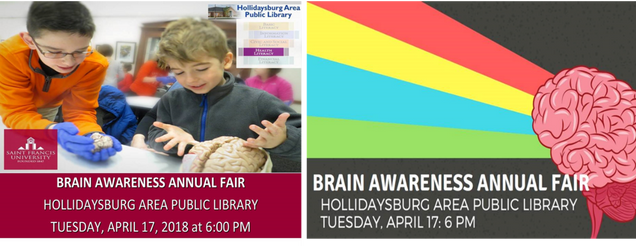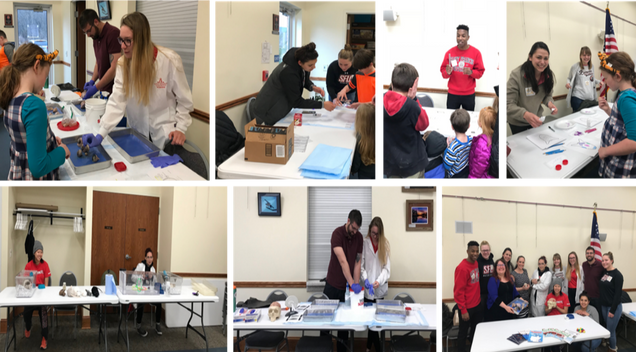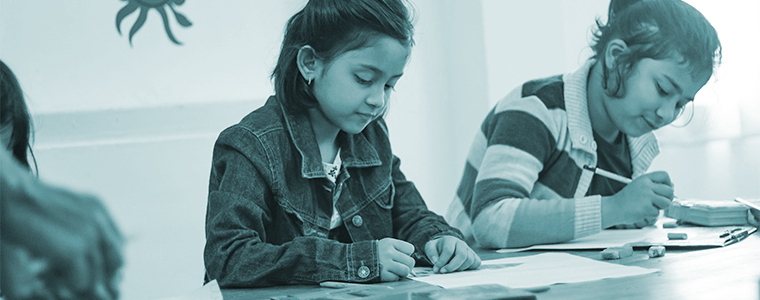The Neuroscience of Fun!
Creating an Avenue of Public Education Through Academia-Community Partnership
Shlomit Flaisher-Grinberg, Saint Francis University
Melanie Ramsey, Hollidaysburg Area Public Library
Abstract
The field of neuroscience offers exciting, yet complex, insights into the human mind. In recent years, the need to improve dialogue between neuroscientists and the public has been recognized, and an emphasis has been placed on the generation of public-based programs which reach outside the academic environment and into the community. One promising avenue includes public libraries, which offer a reliable, educational and social atmosphere. The current project was designed to generate a partnership between the Department of Psychology at Saint Francis University and the personnel at the Hollidaysburg Area Public Library, Pennsylvania, to allow the generation of a neuroscience-based outreach program. It was envisioned that the program would serve to improve the communication of neuroscientific data to the general community, involve faculty and students in community-engagement activities, and support the library’s goals of offering attractive, fun and informative educational opportunities to its members. The analysis of feedback collected thus far suggests that the program attracts public interest and is perceived as mutually beneficial for both the academic and community partners.
Introduction
The field of neuroscience is an interdisciplinary field which aims to study human development, cognition and behavior via the exploration of the structure and functions of the brain and the nervous system (Schacter et al.). Utilizing some of the greatest technological advancements of the last few decades, research within the field has dramatically improved our ability to understand, treat and restore many aspects of human behavior. For instance, brain-computer interface technology has been successfully used to promote the performance and recovery of paraplegic patients who suffered spinal cord injury (Gui et al.; King et al.). Novel strategies utilizing gene and cell therapies are being consistently developed and tested for the treatment of diseases such as Alzheimer’s and Parkinson’s (Loera-Valencia et al.; Pardo et al.). “Mind reading technology” is now closer than ever, given that neuroimaging technologies can be used to decode the content of visual information directly from human brain activity (Huth et al.), and optogenetic techniques have the potential to modify memories [thus far in rodents (Liu et al.)].
In addition, a range of neuroscientific methodologies is currently being used for the study of the neurobiological mechanisms that underlie some of the most mysterious human conditions. These conditions include the “Alien limb syndrome,” a phenomenon in which the individual perceives a limb as estranged/controlled by aliens, since it performs involuntary movements (Gallant et al.), “Cotard’s syndrome”, a condition in which the individual denies his existence/the existence of body parts (Sahoo and Josephs), “Capgras delusion”, in which the individual believes that familiar persons have been replaced by impostors (Jedidi et al.), and “Synesthesia”, a condition in which stimulation of one sense causes an experience in a second sense (Hubbard and Ramachandran).
Due to the use of complex technical terminology, the dissemination of neuroscientific knowledge to the vast public meets some obstacles. Traditional peer-reviewed articles are not always accessible to the non-scientific population, and media summaries of neuroscientific articles have been shown to misrepresent data and lead to misleading conclusions (Gonon et al.). With the recent proliferation of predatory, sham scientific journals, which lack proper peer-review process or editorial supervision, non-scientific data reach publication (Klyce and Feller). Thus, it is not surprising that the gap between neuroscientific facts and public knowledge has allowed the generation of unestablished myths, such as the idea that we only use 10% of our brains or that humans can be divided into left vs. right “brain thinkers” (“Neuro-Hit or Neuro-Myth?”).
In recent years, the need to improve the communication of neuroscience research to the public has been recognized (Illes et al.; Robillard and Illes). Many organizations have attempted to bridge the neuroscientific gap between academia and the public using outreach programs and educational websites. For instance, the Society for Neuroscience offers various resources to educators, and operates a “find a Neuroscientist” program which allows educators to arrange a classroom visit by a neuroscientist (Society for Neuroscience). The Dana Foundation supports a wide range of brain-health programs for diverse audiences, and provides instructional materials and funding for the globally celebrated “Brain Awareness Week” (Dana Foundation).
The attempt to create new avenues for public-oriented neuroscience-centered educational programs can reach into public spaces that are open to a population of diverse ages, backgrounds and interests. Among these, public libraries offer an inclusive learning environment that integrates knowledge-seeking principles with a stimulating social setting. Outreach programs, designed to introduce the public to the exciting and intriguing wonders of the brain, can be integrated into the curriculum offered by public libraries, and serve to improve the experience and engagement of the public with the field. To pursue this goal, the current project was designed to generate an academia-community partnership, which will mutually explore the needs of the community, and enable both partners to create, promote and deliver informative and enjoyable programs. It was hypothesized that this avenue would receive community interest, support library turnout, improve the public comprehension of neuroscientific data, and create novel opportunities for community-based service learning.
Methods and Procedures
The Hollidaysburg Area Public Library, a 501(c)3 organization, has been identified as a community partner for the project. This Pennsylvania library has been in existence for nearly 70 years. It provides the Hollidaysburg area community (approximately 24,000 people) with recreational reading and listening materials, research and educational materials, reference resources, internet access, child and adult programs, and life-long learning opportunities. It is classified as a suburban library in an area in which the high school dropout rate is 1% and the poverty level is 11.3%.
Following the formation of an academia-public partnership between the Department of Psychology at Saint Francis University (SFU) and the Hollidaysburg Public Area Library at Hollidaysburg PA, both partners focused on identifying common goals to generate a unified definition of the program, mutually engaging in program design and marketing (see Picture 1), and establishing the procedures required to support neuroscience-focused, academia-based teaching within the library curriculum. The success of the program was evaluated using feedback (testimonies) generated by the public, involved students, and the community partners. Additional parameters included the approximate number of attendees at each event, as well as indirect measures of community interest in the program.

Results
The program was established in April 2016, and has been successfully delivered since, with 1-3 “Brain Awareness” talks and one “Brain Awareness Fair” per year. Talks receive a steady attendance of 40-50 individuals (children and adults), and the Fair receives an attendance of over 80 individuals. The program draws much attention from the public (in the form of inquiries) as well as the local media (newspaper and TV coverage). Informal evaluations of the project, generated by the public, library personnel and involved students are very positive, and interest in the continuation of the partnership is mutual. Specific description of the program is indicated below.
Brain Awareness Talks
Various neuroscience-related topics have been included in the talks delivered thus far. For instance, the April 2016 program focused on the biological and psychological processes implicated in learning and memory. The introduction of brain areas which participate in learning and memory was supplemented by hands-on activities which focused on the training of live rats (running in a maze), and generated much excitement and engagement (see Picture 2).

The April 2017 program focused on the various human senses (sight, sound, taste, smell, touch), and included numerous fascinating perceptual illusions. The July 2018 program focused on the anatomy of the brain, and was accompanied by the dissections of sheep brain specimen (see Picture 3).

The April 2018 program (“Brain Awareness Fair”, see Picture 4) included 10 college students operating various educational tables from a brain & eye dissection table to an area where the effects of alcohol on the nervous system were demonstrated using microscopes and a water flea specimen known as the “Daphnia Magna”. Another table helped the attendees to create taste maps of their own tongues, and another demonstrated a variety of perceptual illusions. A section of the fair was dedicated to rat training, and another to puzzles, coloring, and a variety of gifts provided by the Dana Foundation (brain-shaped erasers, stickers, and so on).

Community Partner Testimonies
“We were immediately interested in a partnership to bring neuroscience to our library users, and were eager to participate in planning and designing a public program with Dr. Flaisher-Grinberg. The programs were successful and well-attended from the very first, and different concepts were explored based on public interest and input. Together, we considered the audience and the possible ways learning could be organized in a library setting. In a public library, the approach must be a little more flexible since the presenter has no way of knowing how many people, and of what ages, will attend. The activities were appropriate, interesting, informational, and entertaining, and allowed individuals of all ages to meet and talk personally with students and scientists. Some of our participants have shared that they are now interested in learning more about neuroscience, considering neuroscience as a possible career, or starting a new neuroscience-based hobby due to this partnership. We are very proud to partner with Dr. Flaisher-Grinberg and SFU.” (Ms. Melanie Ramsey, Director of Youth and Children’s Services at the Hollidaysburg Area Public Library).
“We are proud to offer free neuroscience programs at our library through this partnership. Our library patrons of all ages have attended the programs with great interest, and have especially enjoyed the hands-on aspect, which provides a learning opportunity that could not be possible without a professional partnership of this kind. Some families have attended multiple events, realizing an interest in the topic which cannot be covered in only one or two sessions. There is much scope for future programs! This partnership would not be possible without the hard work and initiative of Dr. Flaisher-Grinberg and the students of the SFU Psychology Department.” (Janet Eldred, Director of the Hollidaysburg Area Public Library).
Public Testimonies
“We loved the interaction with the college students, they were all extremely knowledgeable, outgoing and interesting. There were many different stations, but my boys were most intrigued by the brain illusions and tuning forks. I couldn’t get them away from that station, they were having so much fun trying to decipher what each card meant! Wonderful program put on by a great group of students and their professor.” (Melissa Garrity).
“My family has attended two of the Brain Awareness events hosted by Dr. Flaisher-Grinberg and her students. It’s truly hard to summarize the great benefits of this program for my family. My children, Ben, age 10, and Chloe, age 11, have been so inspired by the program that both have decided to pursue science fields in their future education. For our children, who attend a small school, this hands-on experience with goggles, scalpels, and dissections may not otherwise occur until college. Our school system simply can’t afford these opportunities. The partnership between the SFU Psychology Department and the Hollidaysburg Area Public Library offers such a benefit to our rather oppressed socioeconomic community. I wholeheartedly thank SFU for this amazing and educational opportunity for my family.” (Jennifer and Dave Wagner).
Student Testimonies
“I really enjoyed the Brain Awareness event. Watching young kids enjoy the brain activities and learn about the brain was awesome. I thought teaching young children about the brain was a wonderful experience to be a part of.” (Amber Rogers).
“I thought the event was great because it was bringing kids closer to science. Watching them get excited to hold a brain or a rat is simply wonderful!” (Christine Geiger).
“The brain awareness event allowed me to break out of my comfort zone and help young kids get excited about learning. This event not only made me like my field of study more, but it allowed kids to learn more about something they probably did not know much about”. (Cecilia Garza).
Discussion
The field of neuroscience has experienced accelerated growth in recent years. Newly acquired neuroscientific knowledge has advanced the understanding of the biological processes that underlie human behavior, and created new avenues for the treatment, attenuation and prevention of various neuropathological conditions. The field of neuroscience impacts financial, pedagogical and legislative decisions, and has the potential to stimulate philosophical, moral and ethical debates. The accurate representation of neuroscientific methodologies, findings and implications is not always available to the public, and when conveyed via semi-scientific journals, concrete data can be misrepresented and thus misunderstood. For these reasons, programs which aim to improve neuroscientific comprehension and engagement in the general public are of value. Curricula which invite the community into the academic environment can be successful (e.g., science days, lab tours, etc.). However, outreach programs, which extend into the community setting, offer efficient, kid/family-friendly opportunities for public education. Libraries are open to individuals of various ages, backgrounds, needs and interests. They offer an informative as well as a social environment, and many aspire to design stimulating public-targeted programs.
The Hollidaysburg Area Public Library is among these libraries. It aims to attract attention, and create a steady stream of public visitation, by hosting various programs, clubs and interest groups. For instance, the library hosts the weekly meetings of the local Girl Scout troop, Canasta club, Knitting club, Lego club, etc. It offers classes designed to educate the community on subjects such as computer literacy, technology and taxes, art, music, health and science (engineering), and its personnel are always looking for new avenues to enrich the library’s monthly curriculum. These properties make the Hollidaysburg Area Public Library into a mutually engaged partner, which takes equal part in the design, organization and public dissemination of the program described above. Specifically, the content of the talks is decided based on public interest, dates are scheduled based on the library curricula, and material constraints are subjected to the library’s safety concerns and regulations. The library personnel communicate with the public via various media channels (newspapers, webpage, Facebook), and thus increase public awareness of the program. On the other hand, SFU personnel (faculty and students) gain the opportunity to bring the neuroscience of fun out of the classroom. Students gain the opportunity to practice instructional skills, communication skills, organizational skills, and enrich their personal and professional development. Faculty gain the opportunity to increase public awareness and knowledge regarding neuroscientific principles, and support the recruitment efforts of their institution, and the public gains an opportunity to experience fun and exciting educational activities.
An analysis of testimonies collected thus far indicates that the partnership between the Department of Psychology at SFU and the Hollidaysburg Area Public Library is perceived as mutually beneficial. Both partners are enthusiastic about the program, are proud of its success, and are interested in the continuation and development of this partnership in the future. Both partners feel that they share responsibility for the design, marketing and implementation of the program, and the ability to work together towards a shared goal is a source of satisfaction between both parties. Moreover, the benefits to students involved in the program and to the public are clear. Student comments indicate that they perceive the program as enjoyable and engaging, and public comments indicate that the program succeeds in its goal of drawing interest and attention and is perceived as an appealing and unique opportunity to develop the entire family’s interest in neuroscience.
It is important to mention, however, that among the limitations to the project is the current lack of evaluation of direct measures of community partner satisfaction, students’ skill acquisition, and impact on public comprehension of neuro-scientific data. It is recommended that future projects will employ valid surveys and questionnaires to assess the multi-modal impact of the project on all parties involved, and its ability to reach its designated goals. It is also suggested that additional avenues for scientific outreach via community partnerships be explored.
Acknowledgements
This project would not have been possible without the following: Ms. Melanie Ramsey, Library coordinator and a partner in creating the program; The Dana Foundation and the National Institute of Health, Office of Communication and Public Liaison; the SFU Psychology Club chaired by Mr. Adonte Haddox; and Ms. Lisa Georgiana, Director of the Center for Service & Learning at SFU.
